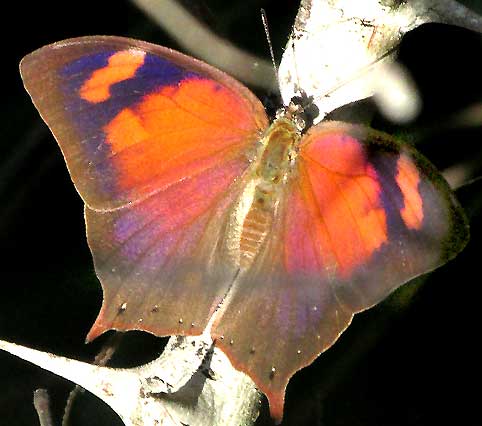Excerpts from Jim Conrad's
Naturalist Newsletter
Entry issued on July 26, 2019, from near the forest just west of Tepakán; elev. ~9m (~30 ft), N21.053°, W89.052°; north-central Yucatán state, MÉXICO
Thorn-scrub LEAFWING
In early morning as I was chopping a trail through the thornforest near the hut, a butterfly I'd not seen before showed up basking on a very spiny branch of Randia obcordata, as shown below:

It's getting hard to find new species to add to our Yucatan Butterfly Identification Page so this was a good find. As usual, sending the above image to volunteer identifier Bea in Ontario resulted in a quick reply: "Thorn-scrub Leafwing, FOUNTAINEA HALICE," she said. The name couldn't have been more appropriate, for here our regenerating forest is pure "thorn-scrub." Still, sometimes the species is called the Ruddy Leafwing. The species belongs to the big Brush-footed Butterfly Family, the Nymphalidae.
The Thorn-scrub Leafwing is distributed in lowland areas from Mexico south through Central America to Bolivia in South America. Its caterpillar stage feeds on the Euphorbia Family genus Croton, abundantly found in our thorn-forest. This is one of those caterpillars living inside a rolled-up leaf whose margins are held together with fine silk.
We've seen another leafwing species, the Red-striped Leafwing, displaying similar features, especially the little "ear" at the base of the hindwing, and the powder-blue sheen covering parts of the wings. The Leafwing tribe, the Anaeini, comprises about 87 tropical American species distributed in eight genera. They're characterized by very rapid, strong flight, stout bodies, those "ears" on their hindwings, and all, when they perch with their wings held over their backs, are beautifully camouflaged, looking like dead leaves or tree bark. It's good to see these "variations on a leafwing theme."